Winter sports pitch maintenance
This sports pitch maintenance guide covers all of the key practices, including creating new rugby pitches and closed-season and mid-season renovations.
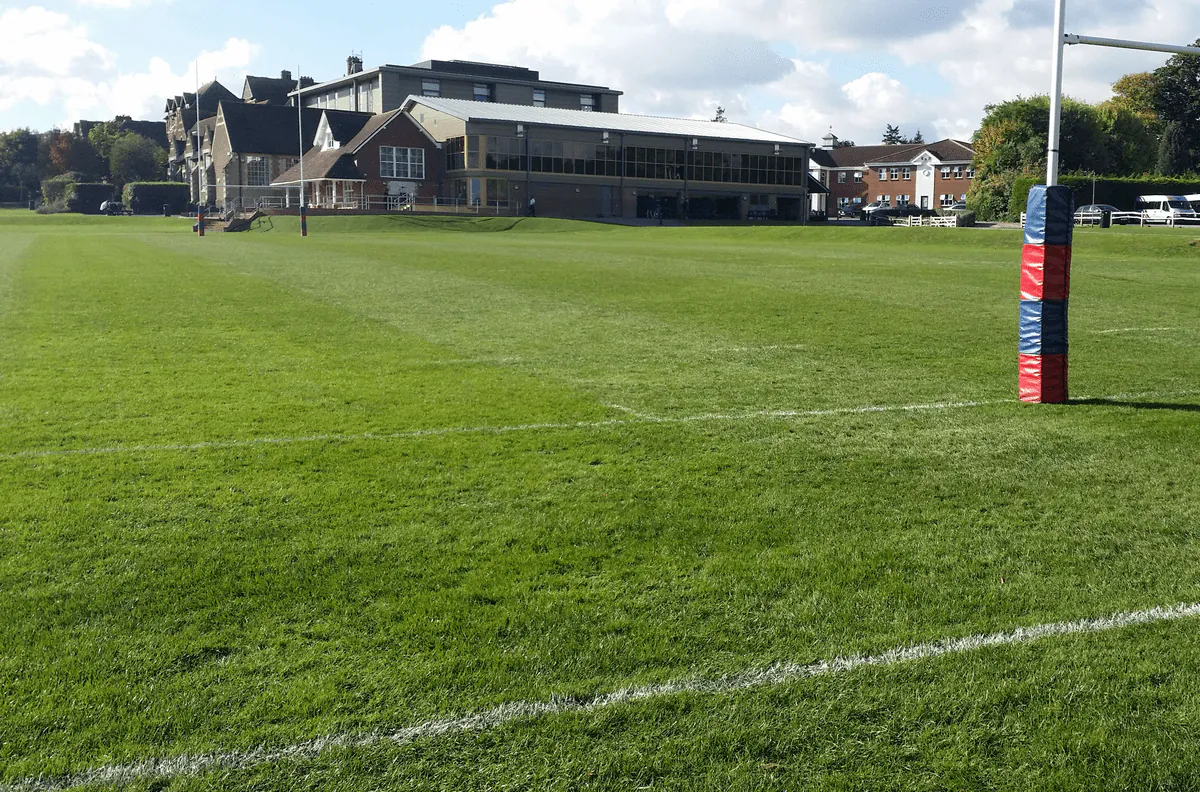
The challenge of any sports pitch maintenance guide is to consider the variances in budgets and resources from local pitches right up to the professional level. Here, we have covered all aspects of general grass pitch maintenance and best practices, letting groundsmen utilise what’s practical for their situation.
Choosing sports pitch grass seed
Germinal recommends sowing 100% Perennial ryegrass (Lolium perenne). The off-season window – during which sports pitch repairs can be carried out is usually short. And Perennial ryegrass typically germinates well at the prevailing soil temperatures in late May/early June. It establishes quickly, which makes it the ideal grass for rugby pitch maintenance and other grass sports.
There are other grass species that offer good wear tolerance, the main candidate being Smooth-stalked meadow-grass (Poa pratensis). This species is very hardwearing but requires a higher soil temperature than Perennial ryegrass to germinate and establishes more slowly. Therefore, it is not effective for completing a rugby pitch renovation within the limited timeframe of 10-12 weeks.
However, Smooth-stalked meadow-grass can be a useful option for sports pitch repair when bought as turf and is sometimes mixed with Perennial ryegrass for this purpose. It is also sometimes used on new-build pitches where the time constraints of a renovation period do not apply.
The use of modern amenity grasses of high germination and purity is of paramount importance if rapid repair is to be achieved. Seeding should be carried out using a mixture of purpose-bred varieties of perennial ryegrasses which are highly rated in table S1 of the BSPB recommended list. A sports seed mixture such as A20 Premier Ryesport is recommended.
The choice of sports grass mixture is, however, only part of a seasonal sports and rugby maintenance schedule. The maintenance of good drainage and the relief of surface compaction are equally important.
Creating a new sports pitch
Sports pitch measurement
| Sport | Area |
| Rugby League pitch size | 100 m x 55 m (recommended) 122 m x 68 m (maximum) |
| Rugby Union pitch size | 144 m x 70 m (maximum) |
| Association Football pitch size | 90 m x 40.5 m (minimum) 120 m x 90 m (maximum) |
Source: Sport England
Preparation and drainage
A good drainage system is of paramount importance if the pitch is to sustain high usage. Drainage specifications vary widely depending on the individual site conditions. But whatever the design, it should be capable of removing excess water either by natural rainfall or irrigation.
A typical system might have main drains, formed on a grid-type system at a depth of 450-900mm deep. This is to avoid damage from sports pitch maintenance machinery. The distance between drains will vary from 2.5 m on heavy soils to 12.5 m on sand. A fall of 100-200 mm is considered ideal.
Surface drainage
Open, well-textured topsoil will help to remove surface water. A mixture ratio of three parts sand to one part topsoil is ideal. Slit drains at 300-600 mm centres, back-filled with sand, to a depth to suit underlying soil layers will give rapid movement of surface water. Slit drains should run at right angles to the existing drainage system. The benefits of surface drainage are:
- Better playing conditions
- Better aeration
- Improved traction, quality and durability of the turf
- Improved root development
- Better soil structure
- Quick drying of the soil improves soil temperatures
- Early growth
Sowing sports pitch grass seed
Rugby pitches are typically larger than football pitches. The minimum size for the playing area is 68 m wide and 94 m long, plus six metres at each end for the in-goal area. Typically, this extends to 100 m long and 70 m wide with larger in-goal areas. Thus, full-size rugby pitches are often taken to be 10,000 m² (1 hectare) in total.
The first step is ensuring you are sowing the sports pitch at a suitable time of year when soil temperatures are conducive to rapid uniform germination. It cannot be underplayed how important rapid uniform germination is.
Swards that are slow to establish because of either low temperatures or lack of moisture will never be as healthy as swards that establish rapidly. Plants that struggle while establishing are more susceptible to disease and competition from weeds.
When sowing Perennial ryegrass seed on sports pitches, the ideal soil temperature for quick establishment is 10-20°c. The warmer end of that scale sees the most rapid germination.
In a typical year, this makes late April until mid-June the best window for establishing a sports pitch. If establishing later in the calendar for use the following spring or in early summer, sowing in mid-August to late September is the window to target.
When sowing sports pitch seed, it must be evenly spread. For this purpose, a specialist seeder must be used. The correct amount of grass seed should be sown across the pitch in two or three directions.
There are many effective types of seed drill, including disc seeders that will open a slit in the soil, then dropping the seed in and closing the gap behind. And there are drills that create numerous holes or dimples, dropping the seed into those and closing gaps.
They can all work very well as they put the seed into the soil at the correct depth (approximately 10-15 mm in the case of perennial ryegrass). Plus, they close and firm the soil behind them, thus ensuring good seed-to-soil contact, which is imperative to ensure uniform seed establishment.
When grass seed is sown at the correct depth and the soil is firmed around it in this way, then the two factors that are crucial for germination, moisture and warmth are held around the seed. Emerging seedlings also have a firm anchor point in the soil.
Grow-in period (first 12-16 weeks)
Provided the grass is growing strongly, the first cut can take place when the plants are 50-60 mm in height. Eventual heights of cutting differ slightly for different winter sports. In the case of football pitch maintenance, the height should be taken down to 35-40 mm after two or three cuts. 35-40 mm is a good height to maintain the pitch during the grow-in, with a view to cutting down to a playing height of 25-30 mm when the season starts.

Meanwhile, pitches used exclusively for rugby are usually kept slightly longer than those for football with typical playing heights of 35-60 mm (Premiership pitches might go down to 25 mm). A grow-in height of 35-40 mm is still applicable, though, because it accelerates the establishment of the pitch.
Closed season renovations & overseeding existing pitches
Longer playing seasons and busier fixtures lists means the renovation period is getting shorter, with a brief, eight-week closed season not uncommon. Therefore, immediately after the last game of the season, renovation work should start with scarification, then spiking or slitting to improve aeration, root development and drainage.
Hollows and damaged areas should be levelled with loam or sand. Areas to concentrate on differ from sport to sport but are typically goal mouths and centre spots on football pitches and try lines on rugby pitches. Also, it might be necessary to topdress the entire pitch with sand, brushed into the surface to restore levels.
Winter sports pitch overseeding should be carried out with a mixture of 100% perennial ryegrass at a recommended rate of 20-25g m/². A seed drill should be used for this as the seed will be inserted into the soil exactly where it needs to be.
Everyone has their preferences here; dimple-type seed drills can be effective but are more dependent upon soil conditions being favourable. If it’s too dry, seeds may not be sown at the correct depth or ‘tucked’ into the soil adequately. In recent years, disc seeders have come to the fore because they tend to produce more consistent results.
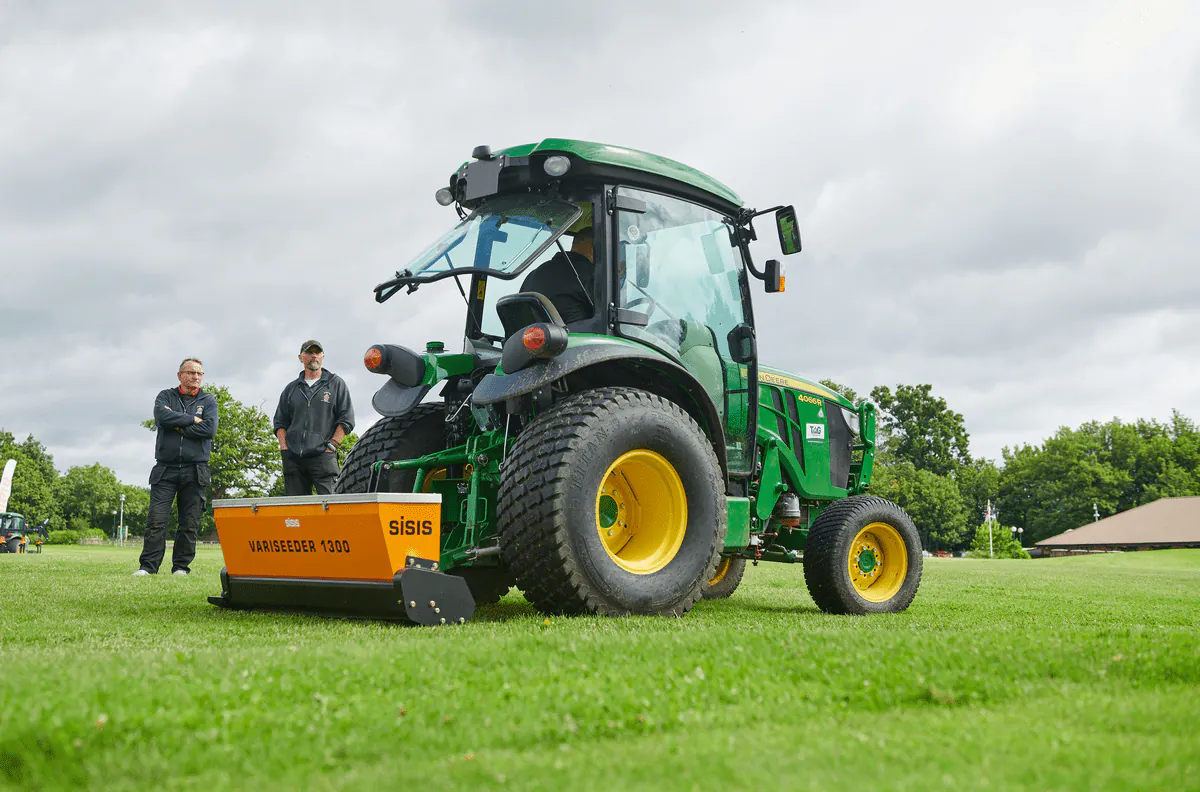
Once new seedlings have established, a slow-release fertiliser with a high nitrogen content such as GSR Tri-Phase 18-3.5-8 should be applied.
If a pitch is in very poor condition and where the budget allows, an option is to ‘Koro off’ the surface of the pitch. This sports pitch maintenance practice is now widely used on elite-level pitches. Using a machine called a Koro Field top maker, the surface of the pitch is heavily scarified to remove up to 80% of the existing surface.
The pitch can then be aerated, topdressed and resown at a rate of 40-50g/m². This method is great for removing a build-up of thatch and undesirable weeds and grasses while refreshing the surface.
Although not practical on an annual basis on all but elite pitches, it is perhaps an option to re-invigorate a pitch every now and then. This should not be seen as a magic wand, though. Some surface issues like moss and broadleaved weed ingression can be caused by underlying issues such as poor drainage and these would need addressing to solve those issues in the long term.
Sports and rugby pitch maintenance during the playing season
Keep the playing surface clean
A groundsman’s first objective should be to keep the playing surface clean and free of debris. Regular light verti-cutting, scarifying or brushing can remove excess thatch while hoovering loose material reduces plant competition (broad-leaved weeds) and gives your grass sward more daylight and soil nutrients.
Aim to do this as regularly as possible – ideally, once a week in summer and fortnightly in the wetter autumn and winter months. If a purpose-built hoover is unavailable, a mower positioned above the grass can perform a similar function.
Keep the pitch dry
Maximum damage is caused to your winter pitch when it is sitting wet. Regular light scarification or verti-cutting will allow moisture to get through the rootzone as there will be minimal thatch to slow it on the surface.
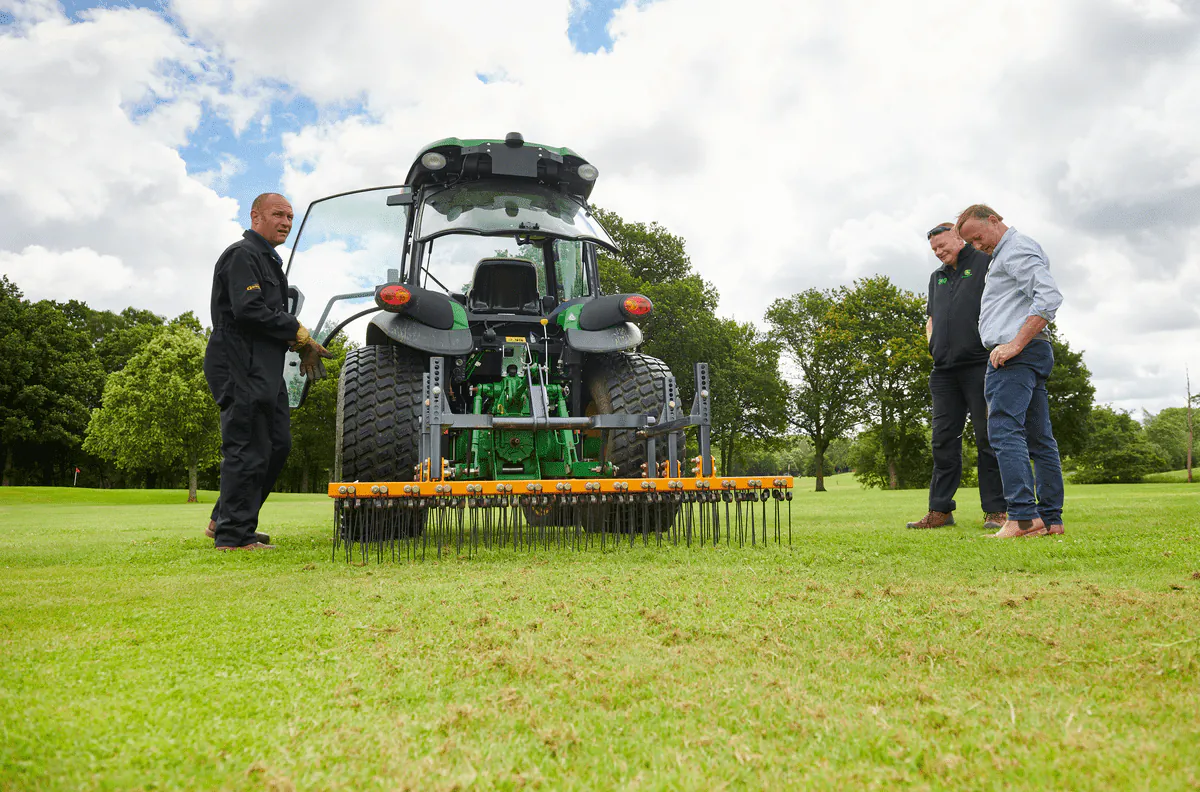
Scarification
Light scarification, usually in the form of verticutting, can be done regularly to keep the surface clean. Generally, deeper scarification is performed in your close-season renovation. The purpose is to remove thatch and unwanted vegetation. At this point, scarification should ideally be followed by topdressing and aeration.
Topdressing
Topdressing of the entire pitch should be done annually and follows heavy scarification and aeration in the season’s renovations. It is also necessary to undertake light localised topdressing of problem areas during the season.
The topdressing to be used depends on your existing soil structure and what you want to achieve. On very sandy soils with inherent good structure, a topdressing compatible with the existing soil should be used. In this instance, you are using the topdressing to address levels and replace nutrients lost while mowing during the season.
The second type of topdressing is sand-based, which is probably the most common. Sand-based topdressing corrects the level of the pitch and, vitally, improves drainage. This is crucial on sports pitches with heavy soil and poor structure.
Professional advice should be sought when choosing a topdressing and it must be bought from a reputable source. Unfortunately, using a topdressing with the wrong structure can cause problems rather than solve them. For example, a sand-based topdressing comprising fine rather than coarse-grained sand can worsen drainage issues.
To summarise, it’s most important that the topdressing you use in sports pitch maintenance is consistent every year. When you which topdressing to use, note this down so that the same type is sourced each year.
Aeration
It’s often said that you can’t aerate too much. And while this statement is largely true, there’s one crucial caveat: ‘You can’t aerate too much if conditions allow’. Punching holes in wet soil is not aerating or aiding drainage. It’s merely punching holes in wet soil. No benefit is achieved, and this might increase compaction. Ultimately, sports pitch maintenance equipment needs to be used effectively.
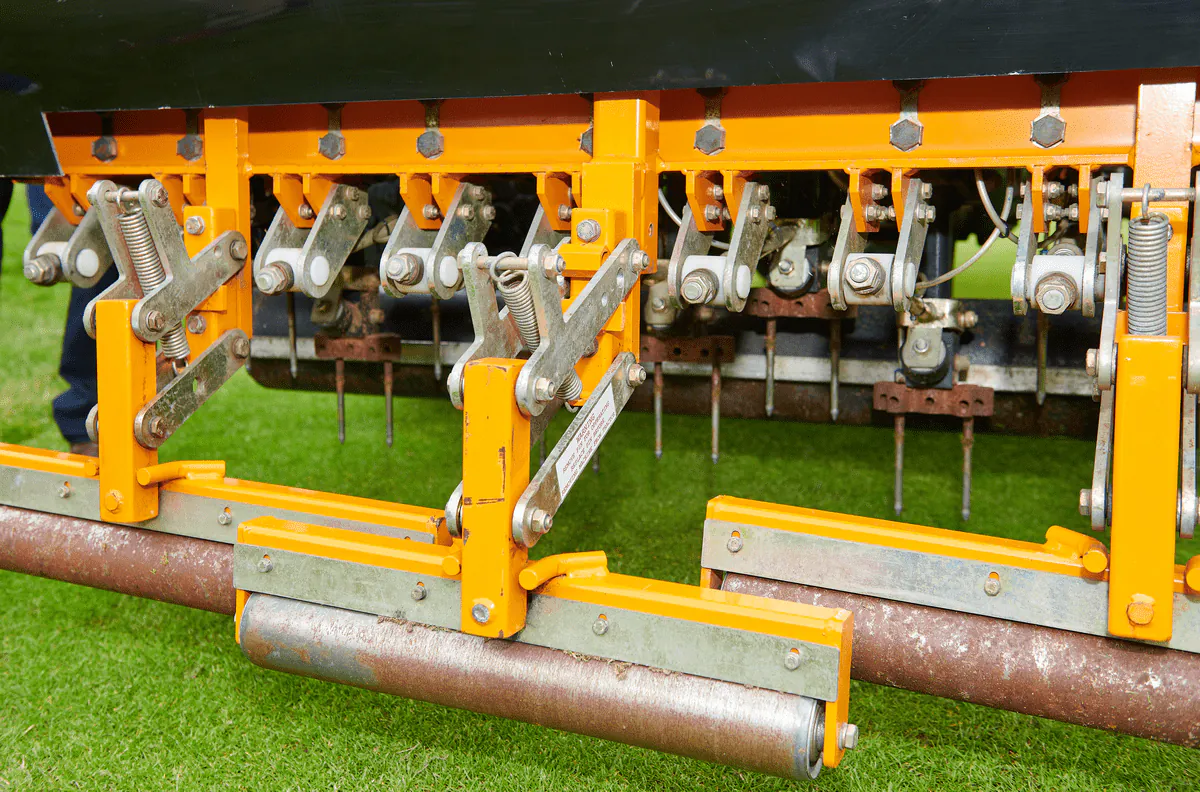
Before aerating, you should know what you want to achieve. Whether you are spiking or using a slitter, aeration’s purpose is to create fissures in the soil, both vertically and horizontally. Fissures create pores for water to filtrate through the soil, air to enter the soil for respiring roots, and feed microorganisms and accelerate the breakdown of organic matter.
To achieve this, soil should be just moist enough to allow the tine or blade to enter but dry enough so that the action is creating disturbance in the soil profile.
The two most crucial times to aerate are once as part of your post-season renovation and then again before prevailing wet weather starts, often in October. Again, if it rains all through October then don’t do it just because you think you should.
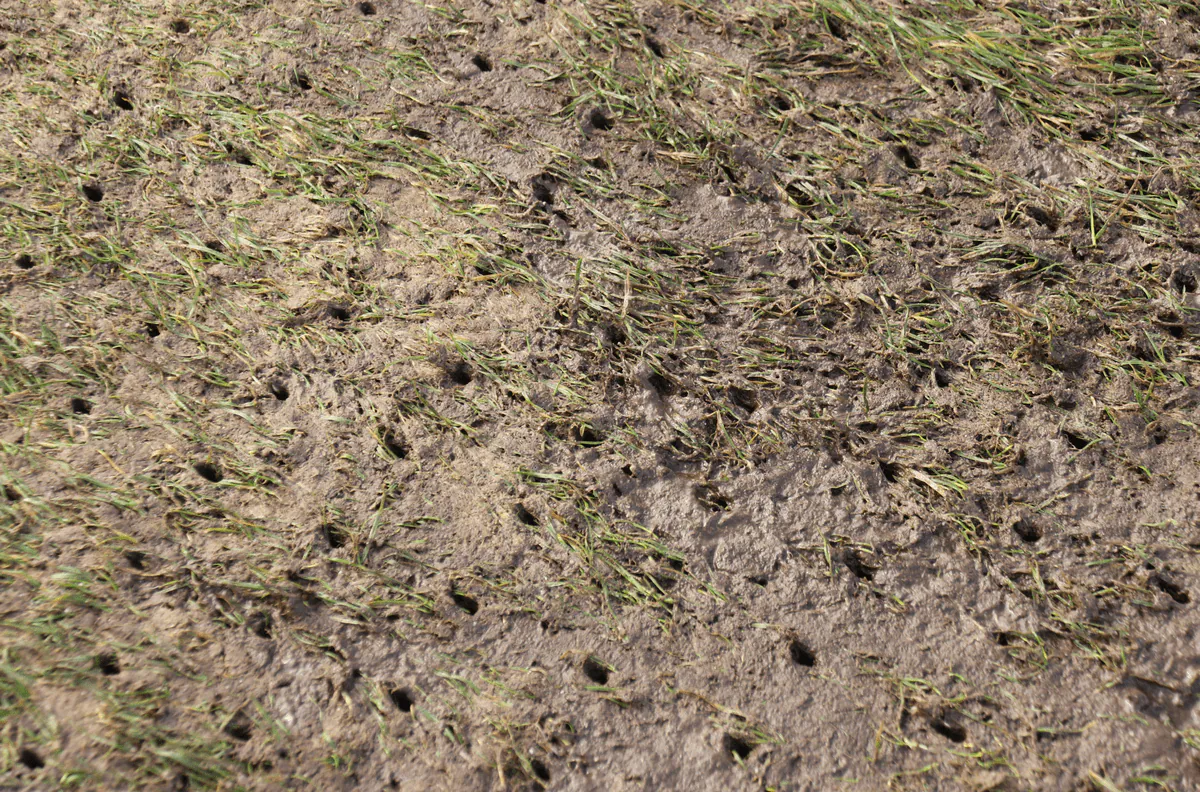
Sports pitch grass cutting
Playing heights differ for various sports; in rugby pitch maintenance typical playing heights would be 35-60 mm, while football pitch heights tend to be shorter at 25-30 mm. If you are catering for both sports, then a compromise of 30-35 mm would be appropriate. Mowing heights can be relaxed somewhat during the off-season, but the grass should not be allowed to exceed 60 mm.

Fertilising sports pitches
With fertiliser, the main constraint is often budget and time. The recommended amounts of fertiliser for a football or rugby pitch per hectare per annum are listed below and the aim should be to provide these amounts if you can.
| Soil-based pitch | Sand-based pitch | |
| Nitrogen | 160 kg | 250 kg |
| Phosphorus | 0-20 kg | 50 kg |
| Potassium | 120-150 kg | 120-150 kg |
Achieving that aim depends on budget and manpower. At the elite level, sports pitch fertiliser will often be applied little and often, as deemed required. With community pitches, however, this is often not practical due to the previous constraints.
To summarise, aim to do the best you can with the resources you have. Slow-release fertilisers are an excellent product for applying larger amounts of fertiliser in an economic and environmentally sustainable way in minimum applications.
If your rugby pitch maintenance budget only allows for one fertilisation, a slow-release product such as GSR Tri-Phase (18-3.5-8 plus TE) should be applied at the time of renovation around April/May time. This can encourage growth and recovery to aid existing grass coverage, act as a pre-seed fertiliser for any overseeding works, and encourage growth right through the close season until teams return in autumn.
Should the budget permit two feeds, August is a great time to apply Novatec Premium (15-3-20 plus TE). This fertiliser will slowly release nutrients throughout autumn.
- April/May – GSR Tri-Phase applied at 35g/m²
- August – Novatec Premium applied at 35g/m²
If you have time and sports pitch maintenance costs are less of a concern for applications, then your fertiliser plan can be expanded.
Weed control
When broadleaved weeds build up on sports pitches, it’s a problem. Weeds are not only an aesthetic issue but they also affect the wear tolerance of the pitch and this negatively impacts the playability. Where a build-up of weeds is significant, a selective herbicide is required to remove them. And this should be done when the sward is growing strongly, perhaps a fortnight after the most recent feed.
If you aren’t fully licensed to apply herbicides, this operation must be carried out by a licensed contractor. Although it can be done at any time the grass is growing strongly, you must understand it’s unlikely the remaining grass will fill the gaps left by the dead weeds.
Unfortunately, a sparse sward can be repopulated by broad-leaved weeds or weed grasses. Thus, it’s wise to plan herbicide application before your end-of-season renovation. A measure to control broadleaved weeds in early May can then be backed up by overseeding your entire sports pitch during renovation. This ensures bare areas are resown with the correct grass species to strengthen the sward long-term.
You should also recognise that often a weed build-up is symptomatic of other failings. Either fundamental issues with the soil structure leading to drainage and compaction issues, a lack of adequate management throughout the season or a combination of the two.
Prolonged periods of neglect when renovations or routine sports pitch maintenance such as aeration and scarification aren’t performed will result in most pitches regressing to weedy grassland areas, appropriate for park use but not for sports.
On some surfaces, including very sandy or heavy clay soil, it’s harder to produce weed-free surfaces even when given an amount of care. In these cases, the long-term solution recommended is an investment in drainage installation.
Sports pitch repairs
Keep on top of problem areas and fix them as soon as they appear. For instance, divots can soon turn into a low area of the pitch requiring more effort to restore the level. Divot scars must be topdressed as often as possible with a mix of seed and sand.

The mix of perennial ryegrass you overseeded the sports pitch with will be ideal for use in your divot repair mix from March to October. For the rest of the year, you should think about using a ‘rescue mix’ with annual ryegrass.
Sports grass seed mixtures like A999 contain an amenity annual ryegrass and tetraploid perennial ryegrass which germinate at lower temperatures than conventional diploid perennial ryegrasses.
This gives the best chance of achieving some establishment and grass cover in colder months. Unfortunately, these grasses will not persist in the long term, and these types of mixtures must not be used for establishing or overseeding a rugby pitch.
Post-match procedure: Rugby pitch care
After each rugby match, clear debris and hoover the surfaces and then follow up with a thorough divot repair. The crucial thing is to try and stand the grass back up and off the ground. Where practical, a light liquid feed is advised – GL6 9.4.6 is the perfect post-match tonic while the pitch is growing.
Sports pitch maintenance advice
Please contact our experts if you require any advice on sports grass seed and rugby pitch maintenance. You can find our other sports pitch maintenance guides here.


